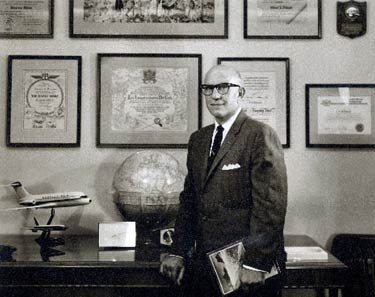|
THE
10,000 HOUR PILOT, AND THEN SOME
This PDF gives
a well-annotated, thorough, and loving biography of Eddie
Bellande, authored by a family member, Ray Bellande. The
image, left, is courtesy of Ray.
Pilot Bellande's career in aviation spanned
nearly 60 years, and it was as diversified and active as
the industry itself during those years. He participated,
with other contemporary pilots like Wiley
Post and Charles
Lindbergh, in some of
the benchmark flight activities of the era.
He flew as a
test pilot for Lockheed in 1926, piloting the first Lockheed
Vega. He checked out Wiley Post in the famed "Winnie
Mae",
and co-piloted Charles Lindbergh on the first TWA transcontinental
run in 1929. As well, he either
organized or directed some of the aviation industry's largest
business organizations.
Edward Antoine "Eddie" Bellande landed once at Tucson, flying
Ford trimotor NC1102,
carrying four unidentified passengers. They visited on November
6, 1928 westbound from El Paso to Los Angeles,
CA. The flight was probably under the auspices of Maddux
Air Lines, Inc. based in Los Angeles.
Indeed, below, from friend of dmairfield.org, John Underwood, is a photograph of Bellande in his Maddux uniform standing in front of a Maddux Ford. It is tempting to conjecture that the Ford is NC1102, but the registration number is not visible. The starboard engine is running.
Eddie Bellande in Maddux Airlines Uniform, 1928 (Source: Underwood)
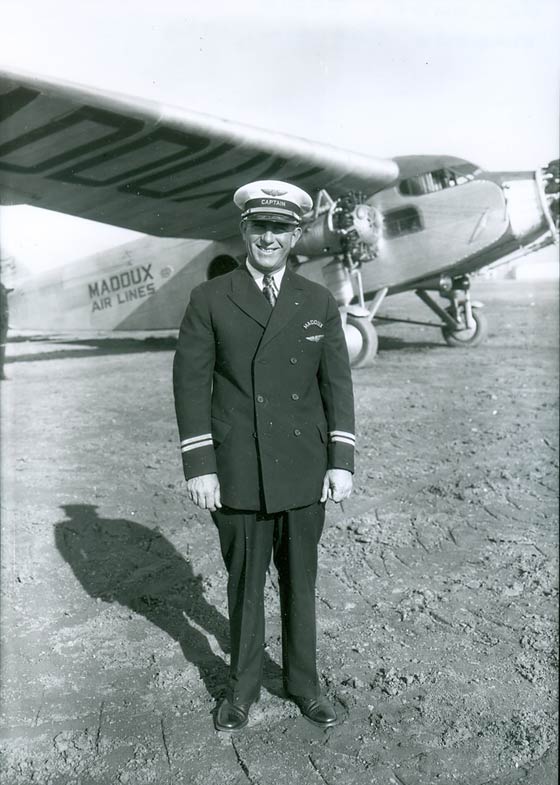 |
Below, shared with us by site visitor Jeff Staines, is a postal airmail envelope signed by Bellande in 1930.
Postal Envelope, September 24, 1930 (Source: Staines)
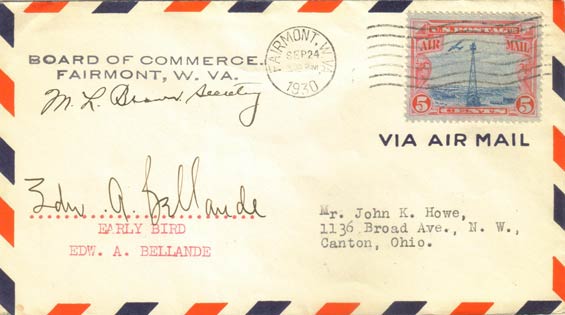 |
Mr. Staines says about the envelope, "This is called an 'Event Cover', signifying an event that usually correlates to the Postmark date of September 24, 1930. It most likely had something to do with Frankman Airfield in West Virginia, but I cannot be sure as of yet. There is no cachet imprinted, so I must continue to research the date and place of Postmark, and/or Ed Bellande's where-abouts at that time."
Significantly, we also find Bellande landing twice during 1931 at the Grand Central Air Terminal at Glendale, CA. His landings were with the Fokker F-32 aircraft identified as NC333N and NC334N. He worked for TWA at that time and was flying west coast routes in those large aircraft.
The wonderful image below, courtesy, again, of R. Bellande,
shows E.A. Bellande in Transcontinental-Western uniform in
1934. The eyes of pilots continue to be forces of nature.
His hat badge is that of Western Air Express (WAE), a predecessor of T.W.A. whose name was subsumed by merger. You can view a high-quality close-up image of the handsome WAE cap insignia at the Lee Willey biography page on this Web site.
A site visitor, who was a relative by marriage to Bellande, shares an anecdote about Bellande as follows:
I didn’t consciously know him until he was probably 70, but he was a great guy. He always had new cars every year or so, and one of them was always a Jeep Wrangler. It never left the pavement of Brentwood, but it was part of his spirit.
One more memory, I remember hearing he got some kind of honor in Wash, DC for emergency landing the mail plane he was flying *and* evacuating all the passengers. He was testifying in front of (congress???) and was asked about how he evacuated the passengers. He said they were mostly able to get out on their own, but there was a larger woman who was having a hard time getting down the aisle. Eddie was asked how he got her out of the plane. He said “I goosed her, your Honor.” And none of the mail was lost, either. He got that out, too.
... he was a GREAT great uncle. He would always bring us fabulous easter baskets and taught me and my brothers how to whip a paddle ball at a 90 degree angle (hope that makes sense). Anyway, he was a fabulous guy. I'm so glad I got to spend time around him. |
This anecdote is substantiated by a listing of medal recipients of the Air Mail Flyer’s Medal of Honor in the journal of the Orders and Medals Society of America (OMSA). The journal for February 14, (1936?) states the following. This award was given for an airplane emergency landing in 1933. He was flying for T.W.A. at the time.
OMSA Journal, February, 1936(?) (Source: Site Visitor)
 |
Below, courtesy of site visitor Joe Kranz, is a U.S. postal cachet dated November 21, 1934. Unlike many cachets of the period, this one carries no commemorative information, like an air race or airport dedication.
U.S. Postal Cachet, November 21, 1934 (Source: Kranz)
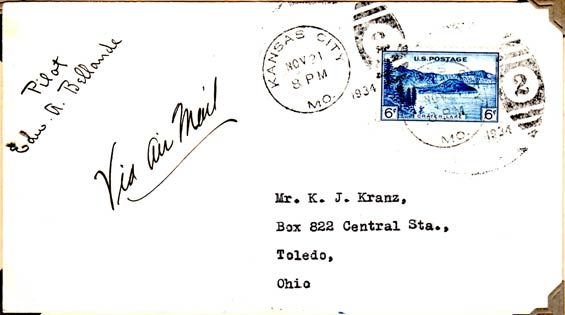 |
Site visitor and frequent contributor Mike Gerow offers the following anecdote from a book written by his uncle, Eugene Gerow. Thanks to Mike. He says, "Eddie Bellande was born in Mississippi on December 19, 1897 and died in Los Angeles on November 16, 1976, just a month shy of his 79th birthday. According to the TWA Active Retired Pilots Association memorial roster, Eddie flew for TWA from 1927 to 1942. Below, from his uncle's book.
"As a 1940 graduate of TWA’s first officer school, Eugene Gerow flew right seat with Eddie in DC-3 aircraft and claimed to be Bellande’s last copilot at TWA. The following excerpt from Gerow’s memoir, The Umpteenth Voyage: A San Joaquin Valley Farm Boy’s Struggle to Become an Air Line Pilot, provides an interesting personal look at Eddie Bellande the man, and insight into what it was like flying with him. As the story opens, circa 1941, Gene is a young co-pilot relaxing in the lobby of the Hilton Hotel in Albuquerque, NM, a TWA crew-change stop:
“…After Dick (Colburn, TWA instructor at Kansas City) left I sat alone in the lobby and pondered my dilemma: I certainly wanted to check out as captain but I certainly didn’t want to face that exacting involvement with as little actual flying time as I had accumulated at the controls of the DC-3 under the random flight crew paring principle which the company now followed. Just then I observed a senior Burbank captain approaching.
“The captain was quite solemn as he stopped in front of me and looked me right in the eye. I began to wonder if I had done something to offend him but he started talking, rather jokingly I thought, about what a poor crop of copilots they were sending out for replacements these days. He went on to say that he thought I might do and asked, ‘Do you want to fly regularly with me?’ I was so astounded I stammered ‘Y…y…yes—uh, Sir!’
“Abruptly he started to turn away, saying, ‘okay, then: tell Corron I said you are to be paired with me from now on.’
“The captain who told me to have myself scheduled with him was Eddie Bellande. He was one of the ‘Old Ones,’ to borrow a phrase from the Navajo, but old as applied here meant in experience, not chronological age: he was also one of the great ones.
“I remembered him even then. Years before, we used to fly across to Rosamond Dry Lake and watch him and other famous pilots of that era testing new airplane designs. We saw him fly the first Lockheed twin there. His name was a household word in flying communities up our way. I had already learned what his reputation was among copilots on TWA: he had left a trail of well-trained copilots with whom he had been paired—Buddy Hagins, Grant Nichols and others before me were forever grateful for what he had done for them and they had said so.
“Burbank Dispatch followed Eddie Bellande’s directive to have me fly with him, but it wasn’t all ‘peaches and cream’: Eddie apparently had something on his mind to which I will refer later, and during this early period of our flying together he just sat there in the left seat, trip after trip, and flew the airplane both ways. It wasn’t much different from the random scheduling I had been experiencing previously.
“I was becoming quite discouraged and decided one day as we were shuttled over to the TWA hangar at Lockheed Air Terminal to taxi our airplane to the airline passenger ramp that I was determined to say something about it if he sat in the left seat again without offering me some ‘stick’ time. He did sit down in the left seat but suddenly jumped up laughing and told me to sit there. After I had taxied the DC-3 across the field he asked me why I hadn’t protested my non-pilotage status and I explained to him just how close we had come to my ‘telling him off’ about it.
“Eddie laughed uproariously at my ill-concealed discomfort but what he then told me rang true: naturally he wanted me to fly ‘his’ airplane ‘his’ way and thought the easiest way to put this across was to fly a few trips by way of demonstration rather than talking about it—this gave him more time to think (and as I said previously, more about that later).
“What a switch: for many weeks I flew the airplane from the left seat day and night, fair weather or foul. After it became apparent that my handling of the DC-3 had improved Eddie handed me the log-sheet clip-board one day and said, ‘Here: you can do it all now.’
“I had never experienced so much flying joy in my whole life, but then as weeks passed and my glow began to subside, I noticed that Eddie was awfully quiet, just sitting there and staring out of the right front cockpit window for hours on end, saying little or nothing during this time interval. I began to really worry now, because I had come to think a great deal of him and I would have been horror-stricken to find that I had offended him somehow.
“One day, I abruptly asked Eddie what was wrong. He came out of it with a smile and said: ‘Can you keep a secret? If you can, I’ll tell you something that is very important to my future, but I don’t want anyone on the airline to know about it right now.’ I promised and then he asked, ‘You know who Jack Northrop is?’ I nodded and he went on to say that Jack had been in some financial straits in his airplane design business and thought he might have to give it up. Eddie added: ‘Jack is probably my best friend and I told myself that I couldn’t just let him go down the drain.’
“Eddie related how he went to night clubs where many big time people hung out and by staying cold sober himself but buying expensive drinks for these people and talking to them as they waxed affluent under the mellowing influence of a good drink, he had accumulated a promising list of potential backers for Jack Northrop’s brilliant undertakings. The only problem for him was that these people wanted him to take over and run the company he had organized. ‘It may be too good to pass up’ said Eddie.
“It was a fascinating story as Eddie had detailed it to me and subsequent events proved that every word he had spoken was true. It was some time before Eddie finally made up his mind to make the change, he loved to fly so very much. But in the meantime, his last TWA copilot was having a ball flying the DC-3 from the left seat.
“Eddie Bellande was quite busy during his last days on TWA trying to make sure before he announced his voluntary retirement that his contemplated move wasn’t going to be a bad one. As I had previously stated, he had schooled me thoroughly on his idea of how a flight should be conducted and then turned the whole thing over to me. One of my non-standard copilot duties became a trip into the terminal building at intermediate stops to pick up the new weather. The captain was supposed to sign for the weather sheet, and I had learned how to render what I thought was a fair imitation of Eddie’s signature.
“Quite often people who were involved financially in an airline and airplane industry dealings would ride along on the jump-seat with us and at stopping-points along the route Eddie would stay on board to discuss important items with these individuals. My most vivid memory of this phase was of leaving Eddie and LaMott Cohu in the cockpit after a night landing at Winslow, where I went in to get the weather. Cohu was destined to be a president of TWA and was quite interested in all facets of the airline operation.
“When I came back up to the cockpit I advised Eddie that we had been re-cleared with a second alternate for ABQ, handing him the new release form. Cohu asked, ‘Doesn’t a new release have to be signed for by the captain?’
“Eddie laughed and said, ‘It’s been signed by the captain alright.’
“The financial wizard took the release from him and looked at the signature, remarking, ‘By Gosh! It looks more like Eddie’s signature than if he had signed it himself!’
“Years later when TWA Captain Bill Harrison and I signed in at the Garrett Corporation executive suite at Los Angeles International Airport to visit Eddie, we had to write down the name of the person we wanted to see, and I wrote the name of the Chairman of the Board, E.A. Bellande. The secretary gasped when she looked at the hand-written name and said: ‘You must have known him quite well: it looks exactly like his signature and very few people seem to have known that his middle initial is A—they always write down Eddie.’” |
Note: Eugene Gerow (1907-2000) retired in 1972 as a senior TWA captain with 32 years of service and 27,000 hours flying time. If he ever flew into Davis-Monthan during his long aviation career, he failed to sign the register. However, early in his professional career, he flew copilot with at least one other D-M signer, Walter L. “Si” Seiler, Chief Pilot of Wilmington-Catalina Airline, Ltd. Gene was a younger brother of Russell T. Gerow, whose photograph and document collection may be accessed here. Another anecdote from this book can be found at pilot Al Gilhousen.
This 1972 image, left, is from Rsy Bellande.
The Albuquerque (NM) Journal, of January 28, 1942 carried news of his retirement from TWA. I know nothing of his post-retirement appointment with the photographic eqipment company.
If you explore this article you'll see in the lower right hand corner of the page a movie advertisement for "Tanks A Million". This film was made by Hal Roach, who has a presence on this Web site through pilot James Dickson, and Lockheed NC905Y.
Bellande was born December 19, 1897 in Jackson County, MS. The 1900 U.S. Census is interesting, because his father, Antoine, was 70 years old at the time, and his father's occupation was listed as "Pilot." In 1900 he must have been a river boat pilot (Jackson is just 40 miles east of the Mississippi River). He had immigrated from France in 1857, so Eddie was a first generation American.
The 1910 Census cites him still living with his parents. His father, age 80 now is still a "Pilot" on a "Steamship." At age 22, Bellande shows up in the 1920 census living in Ocean Springs with his widowed mother. He is a "Laborer" in a "Shipyard."
Molly Lamont, Date Unk. (Source: Web)
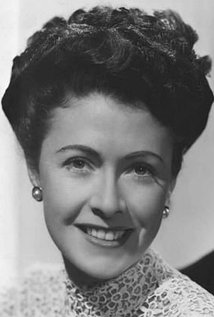 |
During the next decade, Bellande moved west from Mississippi. The 1930 Census places him living with his mother at 444 Crescent Heights Blvd., Los Angeles, CA. This is a neighborhood today of neat homes on well-trimmed properties. His occupation is listed as "Pilot" in the "Aviation" industry.
He was married in 1938 to Molly Lamont, right. Born in South Africa, she was an actress in B-movies in England. She starred in Handle with Care (1935), The Awful Truth (1937) and Scared to Death (1947). Her bio is at the link.
The 1940 Census places Bellande at age 42 living in Los Angeles, CA in a rented home ($94/month). He shares the house with wife Molly (28) and his mother-in-law Edith Lamont (59). I don't know what happened to his mother. His occupation is listed as "Commercial Pilot" for an "Airlines Co." The company was T.W.A. Bellande and Molly had no children.
Bellande flew West November 16, 1976 in Los Angeles. The Los Angeles Times carried Bellande's obituary on November 18,
1976, as did the Hayward (CA) Daily Review of the same date. Note the difference in advertising in this paper vs. the one from 1942. Molly survived him. She was born May 22, 1910 and died July 7, 2001 at age 91 in Brentwood, CA.
---o0o---
Dossier 2.1.49
THIS PAGE UPLOADED: 03/08/06 REVISED: 03/20/06, 03/22/06, 06/23/08, 01/22/10, 02/15/11, 07/01/11, 12/03/15, 01/06/16, 12/15/21, 01/08/23
|








